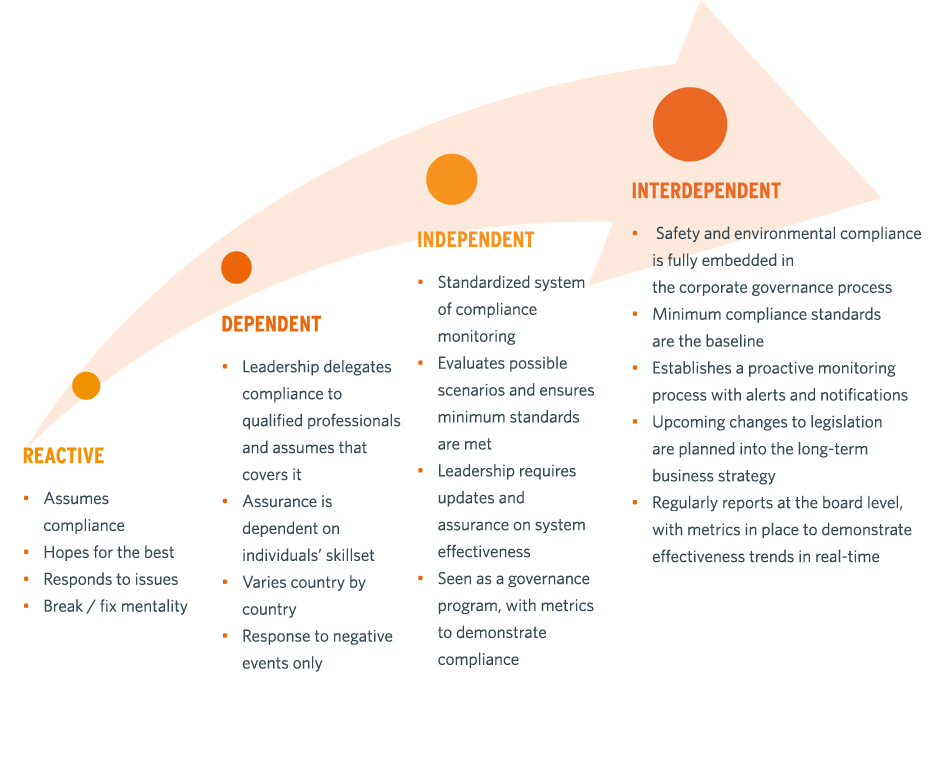Use these four simple steps to map out your EHS compliance transformation plan and move from a reactive to an interdependent approach
Managing compliance across a global company can be complex and challenging. Sometimes, if it’s not done right, it can mean departments are simply waiting for problems to arise rather than proactively preventing them. With a well-informed, data-driven approach, however, your compliance management can mean you’re aware of what’s required before you face an incident.
In this article, we’ve summarized a simple 4-step blueprint to follow when planning your EHS compliance program transformation.
1. Scale your compliance maturity
A good grasp of your current compliance maturity level versus your ideal level is a vital first step.
Here’s a clear view of the spectrum of compliance maturity:

Reactive compliance is retrospective, driven by fixing issues once they occur. This means having no way to assess when incidents may happen, how bad they could be if they do, or having any plans in place to prevent or mitigate them.
Interdependent compliance, by contrast, is proactive. It looks ahead to address potential issues in advance and establish plans to manage the most likely or the highest risk events.
2. Establish your baseline
t’s important to start with a clear understanding of the current state of your compliance program. This should not be a “blame game” exercise — it needs to be non-judgmental and treated as a matter of fact to establish two main things:
- The true maturity position of your compliance program
- The improvements required to move up the maturity scale
It’s important to get a true representation of current status by reviewing as many levels and functions as possible — both internally and externally, to ensure comprehensive coverage.
Internally
Examine the following:
- Skill levels of individuals
- Reporting structures
- Senior health and safety leader’s accessibility to senior officers in the company
- Employees’ view of the safety process
Externally
Seek answers to the following questions:
- How do you collect information about the external regulatory environment?
- Is there a formal review process?
- Have there been regulatory contacts in the past and how where they managed?
All businesses will start at different points along the path to interdependency — for some interdependency may even be too far for them to reach. Use this opportunity for an honest examination of the company’s realistic position and potential, and work to those truths when setting goals and developing plans.
3. Proactive planning
A comprehensive baseline analysis will identify significant gaps which need to be prioritized. Improvements may need to be staggered to manage critical aspects early, with further improvements later. The following aspects will need to be addressed:
Engagement of leadership
In most jurisdictions the CEO is legally responsible for compliance — not the health and safety manager — so they need comprehensive information on the compliance status and upcoming changes.
Ensure leadership is actively involved by setting up a comprehensive, regular report to board level — at least biannually, but preferably quarterly. This report should cover at least compliance and performance.
Plans for improvement
Develop a plan to fill the gaps identified so you can get buy-in for resourcing.
Resources broadly fall into three categories: administrative effort, expense, and capital.
Capital is a long-term issue usually addressed in a fixed financial cycle, but it’s possible to expense smaller costs over the year.
There may be some problems that can be resolved with administrative efforts already available, which will often get significant improvements for little initial cost in the short term. These can represent a good way of getting the program off the ground.
Plan some initial quick successes that can be reinforced in the future. Make sure the plan is SMART (Specific, Measurable, Achievable, Resourced, and Timed).
Metrics
Get a process in place to demonstrate progress. Proactive metrics are best, but a sensible mix of both reactive and proactive works well.
4. Establish regular reviews
This relates to leadership engagement above, and should be embedded in the calendar. Once the process is established, leadership generally becomes more actively engaged in a program and its importance.
Transform your EHS compliance program with RegScan
To manage compliance across a global company requires a well-informed, data-driven approach, so you’re aware of what’s required before you face an incident. It needs to be entirely transparent and honest, while accessible to all concerned levels across the organization — including the board.
This all starts with a combination of clear understanding of internal status and external requirements.
Find out how, with the right regulatory compliance information and insights, you can keep your teams better educated and aware of changes in the EHS compliance landscape. See how RegScan’s EHS Alerts can help your business stay ahead.
